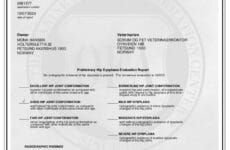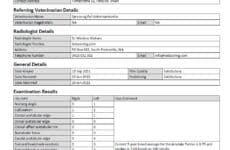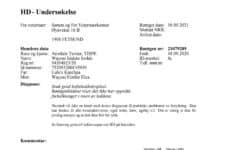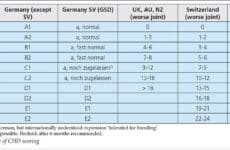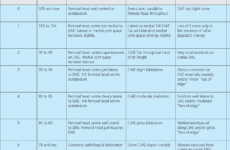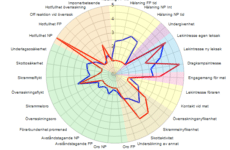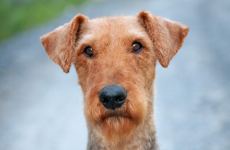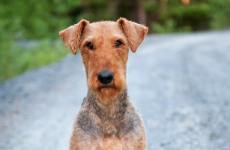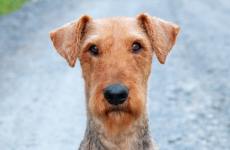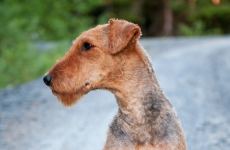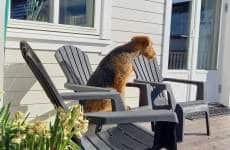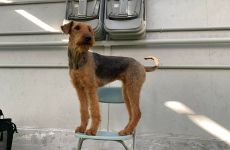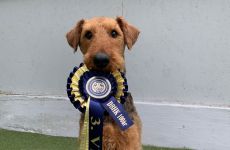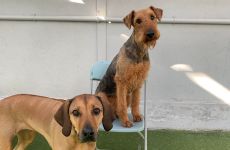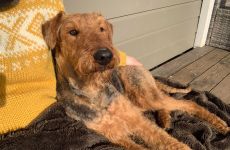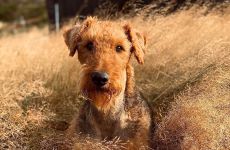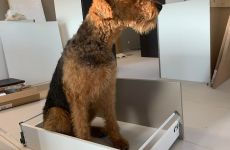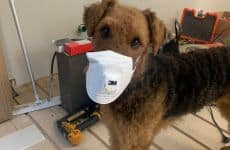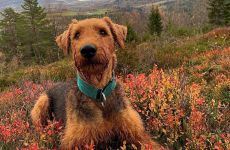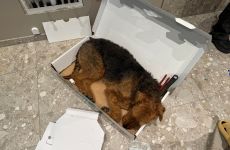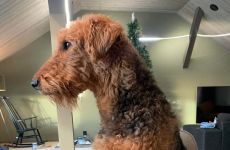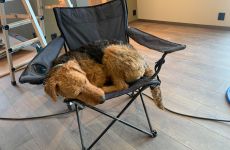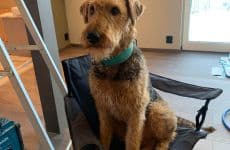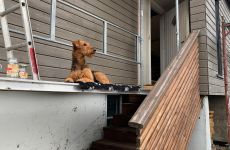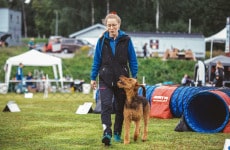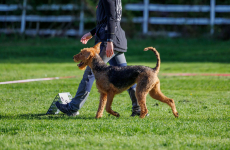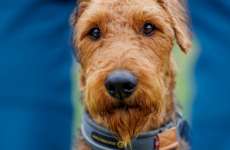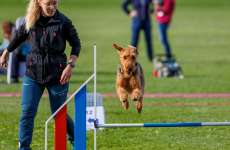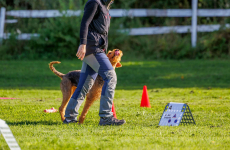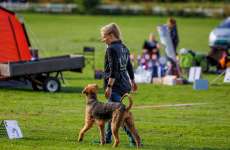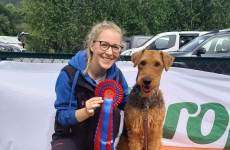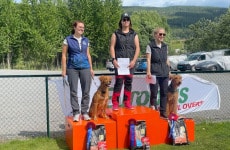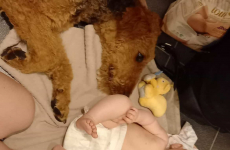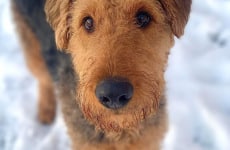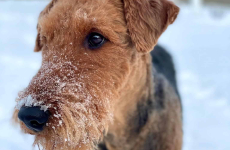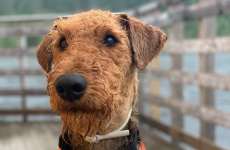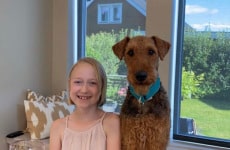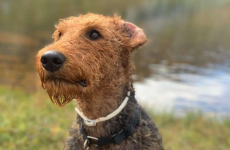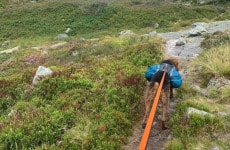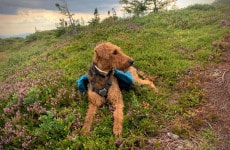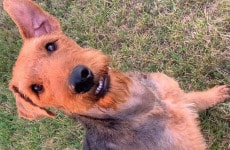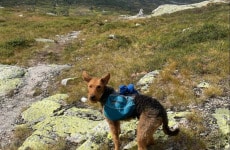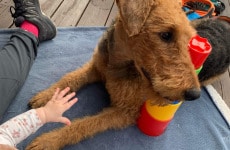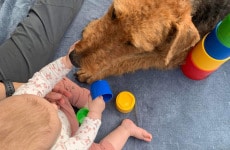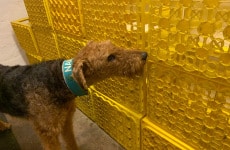

DATA
Reg. nr: NO54823/20
Owner: Kennel Wayosi, Fetsund – Norway
Co-owner: Turid Torget Moseng, Lier – Norway
Height: 62 cm | Weight: 26 kg
Hips: C/B (Norway), A2/B1 (Germany), 4/2 (Australia), Good (OFA, US) | Elbows: 0/0
LTV (Lumbosacral Transitional Vertebra): LTV0
VA (Vertebral Anomaly): VA0 | SP (Spondylosis): SP0
Teeth: Correct and full bite | Eyes: ECVO clear, mild Distichiasis on one eye
Factor IX Deficiency (Haemophilia B, identified in Airedale Terriers): N/N (clear)
Factor VII Deficiency (Identified in Airedale Terriers, F7 Exon 5): N/N (clear)
Genetic COI, according to Embark: 35%
ACHIEVEMENTS
- 3 x 1. Prize diploma rally obedience class 1 (Norway) – official title RL1
- 3 x 1. Prize diploma rally obedience class 2 (Norway) – official title RL2
- 3 x 1. Prize diploma rally obedience class 3 (Norway) – official title RL3
- Multiple 1. Prize diploma rally obedience elite class (Norway) – official title RLE
- Norwegian Rally Obedience champion – official title N RLCH
- NKK’s obedience diploma in bronze
- Companion Dog test with behaviour test (Begleithundprüfung) – official title BH-VT
- Excellent, CQ, CAC at exterior show
LITTERS
HEALTH
Nani is a healthy dog in any way and has never had any health issues whatsoever. She has a strong stomach, shiny and strong coat, healthy skin, healthy physics, and last but not least the perfect working Airedale mentality.
Her first ECVO showed two small extra eyelashes (mild Distichiasis) on one eyelid, but these are not causing any discomfort for her whatsoever. At the moment the hairs have disappeared. Distichiasis is quite common in the breed and rarely leads to any symptoms or discomfort.
Nani has HD B (clear) on the right side, and HD C (mild dysplasia, Norwegian Kennel Klub) on the left side. Her hips have been re-checked at age 2,5 years and there are no signs of arthritis in her hips. When we saw her photos and got the results from the Norwegian Kennel Klub we believed the scoring was kind of strict and decided to re-evaluate her hips after a year or so. We decided to send the x-rays for a second opinion to two different certified veterinarians who do official HD scorings in other countries.
Her hip x-rays were sent to Vetscoring UK, Dr. Mariano Makara (EBVS – European Specialist in Veterinary Diagnostic Imaging, University of Sydney) for a second opinion. Dr. Makara is also one of 4 radiologists on the Radiologists Panel at the Australian National Kennel Council. Her scores came back as 4/2 meaning a score of 4 on the left side and a score of 2 on the right side, with a total score of 6. A total score of 0 to 4 could be considered as “perfect or near-perfect hips“, while 5 to 10 is considered “borderline changes that are unlikely to worsen with age“. Compared to FCI countries (except the Nordic countries) Nani’s left hip is equivalent to A2 (1-3) while her right hip is equivalent to B1 (4-6) (hip score table). Also, see the tables below.
The traditional advice has been that only dogs with hip scores well below the BMS (breed median score) should be chosen in order to apply meaningful selection pressure (https://vetscoring.uk/results-info/). Ideally, only dogs with total scores of 10 or less should be used for breeding and, more specifically, when these scores arise only from parameters 1 to 3, with a 0 score for parameters 4 to 9 (i.e., no detectable osteoarthritis). This is because total hip score, Norberg angle, and subluxation have the highest heritability, whereas secondary change is more likely to be influenced by age and environmental factors.
On the right hip, Nani has a score of 1 for Subluxation and a score of 1 for Crabnial Acetabular edge, while the rest is 0. On the left hip, Nani has a score of 1 for Norberg Angle, a score of 2 for Subluxation, and a score of 1 for Crabnial Acetabular Edge. The rest is 0. Based on these results we feel confident that her hip scores are well below the acceptable scores for meaningful selection pressure, and that her hips would likely be scored as “normal/clear/good” if she was residing in other FCI countries than the Nordic countries and thus be cleared for breeding.
Nani’s hips x-rays was also sent to TGZ Oerzen DE, Alexander Koch, HD/ED ZENTRALE (zertifizierter Gutachter und Obergutachter der Gesellschaft für Röntgendiagnostik genetisch beeinflusster Skeletterkrankungen bei Kleintieren e.V (GRSK)) for another second opinion. The results came back as A2/B1 on the left and right hip, respectively, which is exactly the same score evaluation as Dr. Makara in Australia.
In addition, Nani’s x-rays were sent to OFA (Orthopedic Foundation for Animals, USA) for an HD evaluation, which came back as “Good”. This correlates exactly with the German and Australian evaluations.
We believe that these results give us the confidence to breed Nani, and we strongly believe she would have many good qualities to contribute to a long-term breeding plan. Worldwide, Airedale terriers with C/C hips are often used in breeding as it mostly doesn’t affect them, being a medium-sized dog and mostly not giving any clinical symptoms. However, we do believe that measures should be taken to make sure the hips of the Airedale terrier stay healthy and non-dysplastic. Due to this, we will only breed Nani with male dogs who have A-hips and with a good pedigree- and offspring statistics regarding HD.
- OFA HD evaluation
- HD evaluation from Dr Mariano Makara, Dr med vet, Dipl ECVDI, Specialist in Diagnostic Imaging, Australia
- Evaluation from Dr Alexander Koch, Dr med vet, HD/ED zentrale, Germany
- HD evaluation from Norwegian Kennel Klub
- Comparison of CHD scoring
- BVA/KC scoring mode for CHD


